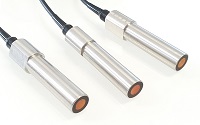
What is Transducer and Different types of Transducers?
A transducer is a device used to convert one form of energy into another. The process of converting one form of energy into another is called transduction. An electrical transducer is a device that is capable of converting physical quantities proportional to electrical quantities such as electrical current or voltage. The physical quantity that is to be measured may be pressure, temperature, displacement, etc. The transducer can be mechanical, electrical, optical, magnetic, piezoelectrical, etc that converts the sensed information into a more convenient form that is easily readable by the user. Typical transducers are headphones, microphones, loudspeakers, pressure sensors, etc.
Types of Transducers
Transducers are of many types and these are described below:
- Primary and Secondary Transducer
- Analogue and Digital Transducer
- Active and Passive Transducers
- Direct and Inverse Transducers
- Null and Deflection Transducers
- Based on the principle of Transduction
We will explain all these transducers one by one.
1. Primary and Secondary Transducer

Primary Transducer
A primary transducer is Defined by which converts the physical quantity into the mechanical displacement. It is a mechanical device for example diaphragm, bellows, and bourdon tube.
Secondary Transducer
A secondary transducer is a transducer that converts mechanical displacement into electrical output. In this case, the output from the primary transducer is converted into the electrical signal by the secondary transducer and it is an electrical device. For example, LVDT.
2. Analog and Digital Transducer
Analog and digital transducer are based on the output generated that is depending upon whether the output is continous function of time it is discrete from.
Analog Transducer
Analog transducers are defined as when the input quantity is converted into the analog output which is a continuous function of time. For example, thermocouples, thermistors, strain gauges, and LVDT.
Digital Transducer
A Digital transducer is defined as the transducer which converts the input quantity into an electrical signal in the form of pulses. Digital transducer pulses are discrete in nature. For example, shaft encoders.
3. Active and Passive Transducers
Active Transducer
An active transducer is a self-generating type of transducer that develops its own voltage or current output. In the case of active transducers, they do not need any external power source to produce the output. So now the question is how they are getting energy to produce output. The energy that is required to produce the output is obtained from the physical quantity being measured. A few examples of active transducers are thermocouples, photovoltage cells, easier electrical crystals, etc.
Passive Transducer
A passive transducer is defined as a transducer that derives power from an external source. They are receiving the power from external power so they are termed externally power transducers. Inductive, Resistive, and capacitive transducers are some of the examples of passive transducers.
4. Direct and Inverse Transducers
Direct Transducers
A direct transducer is a device that measures and transforms a nonelectrical variable into an electrical variable. For example, Thermocouple is used to measure heat, radiation, and temperature.
Inverse Transducers
An inverse transducer is just the opposite of the direct transducer. In this case, if the electrical quantity is transformed into a non-electrical quantity, then it is called an inverse transducer. A piezoelectric crystal is an example of an inverse transducer.
5. Null and Deflection Transducers
Null Transducers
It works on the principle of maintaining zero deflection by applying the appropriate known effect that was the one generated by the measured quantity.
Deflection Transducers
Deflection type transducer works on the principle that the major quantity produces a physical effect that stimulates an analogous effect in opposite direction in some parts of the instrument.
6. Based on the principle of Transduction
The classification of a transducer-based on the principle of transduction is how the input quantity is transduced into the inductance, capacitance, and resistance value. They are called inductors, resistive, and capacitive transducers.
Frequently Asked Questions
What is a transducer?
A transducer is a device used to convert one form of energy into another. The process of converting one form of energy into another is called transduction.
What is an Ultrasonic Transducer?
The ultrasonic transducer is a sound-related transducer. These transducers send the electrical signal to the object, then it sends back to the transducer. This transducer measures the distance of the object.
Also, read about Ohm’s Law
